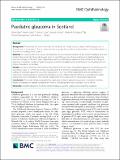Files in this item
Paediatric glaucoma in Scotland
Item metadata
| dc.contributor.author | Beck, Daniel | |
| dc.contributor.author | Galea, Martin | |
| dc.contributor.author | Loo, Cheng Li | |
| dc.contributor.author | Schmoll, Conrad | |
| dc.contributor.author | Burgess, Frederick R. | |
| dc.contributor.author | Montgomery, Donald | |
| dc.contributor.author | Tatham, Andrew | |
| dc.date.accessioned | 2020-03-02T13:30:03Z | |
| dc.date.available | 2020-03-02T13:30:03Z | |
| dc.date.issued | 2020-02-27 | |
| dc.identifier | 266392851 | |
| dc.identifier | 69d2a94f-a802-4341-b625-6d5b1b04c165 | |
| dc.identifier | 85080094526 | |
| dc.identifier | 000520958200001 | |
| dc.identifier.citation | Beck , D , Galea , M , Loo , C L , Schmoll , C , Burgess , F R , Montgomery , D & Tatham , A 2020 , ' Paediatric glaucoma in Scotland ' , BMC Ophthalmology , vol. 20 , 76 . https://doi.org/10.1186/s12886-020-01347-7 | en |
| dc.identifier.issn | 1471-2415 | |
| dc.identifier.other | ORCID: /0000-0001-5543-156X/work/75610584 | |
| dc.identifier.uri | https://hdl.handle.net/10023/19572 | |
| dc.description.abstract | Background The primary aim was to estimate the incidence of primary and secondary childhood glaucoma in Scotland over a 2-year period. The secondary aim was to gauge the confidence and experience of ophthalmologists in Scotland in managing these patients. Methods A 7 question electronic survey was distributed to all consultant members of the Scottish Paediatric Club and Scottish Glaucoma Club. Respondents were asked to report the number of cases and types of childhood glaucoma they had managed in the last 2 years. Respondents were also asked about experience and confidence in a range of glaucoma procedures, number of patients requiring referral to specialist centres and interest in the development of a centre of excellence in Scotland. Results The survey returned a 56% response rate, reporting 85 new cases of paediatric glaucoma in Scotland over the preceding 2 years. 11 (12.9%) had primary glaucoma and 74 (87.1%) had secondary glaucoma. The most common subtype of secondary glaucoma was uveitic glaucoma (n = 29). None of the respondents declared confidence or experience in trabeculotomy or goniotomy procedures. Eleven children required referral to a specialist unit outside Scotland. 85.7% of respondents felt Scotland would benefit from a specialist unit for paediatric glaucoma. Conclusions This survey reflects an appetite for a specialist service for paediatric glaucoma in Scotland. However, further consideration is needed to determine if there is sufficient patient load to maintain such a service. | |
| dc.format.extent | 7 | |
| dc.format.extent | 922060 | |
| dc.language.iso | eng | |
| dc.relation.ispartof | BMC Ophthalmology | en |
| dc.subject | Paediatric glaucoma | en |
| dc.subject | Paediatric ophthalmology | en |
| dc.subject | Glaucoma surgery | en |
| dc.subject | Service planning | en |
| dc.subject | Scotland | en |
| dc.subject | RJ Pediatrics | en |
| dc.subject | RE Ophthalmology | en |
| dc.subject | E-NDAS | en |
| dc.subject.lcc | RJ | en |
| dc.subject.lcc | RE | en |
| dc.title | Paediatric glaucoma in Scotland | en |
| dc.type | Journal article | en |
| dc.contributor.institution | University of St Andrews. School of Medicine | en |
| dc.identifier.doi | 10.1186/s12886-020-01347-7 | |
| dc.description.status | Peer reviewed | en |
This item appears in the following Collection(s)
Items in the St Andrews Research Repository are protected by copyright, with all rights reserved, unless otherwise indicated.

